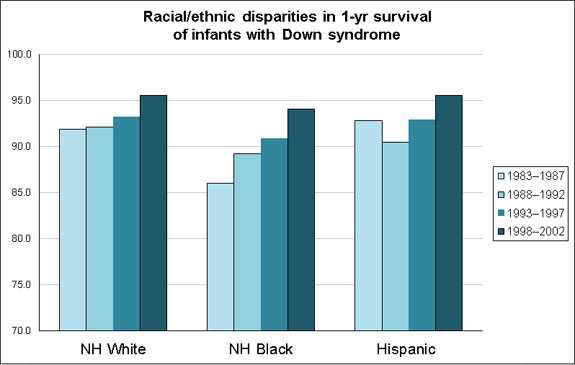Key Findings: Trends in survival among children with Down syndrome in 10 regions of the US

The journal Pediatrics has published a new study: “Trends in survival among children with Down syndrome in 10 regions of the United States.” You can read the article’s abstract here. See below for a summary of the findings from this article.
Main Finding from this Study
Survival among people with Down syndrome improved in the United States over time. Importantly, the greatest improvement in survival was among babies with Down syndrome who were born with low birth weight or born with a major heart defect. Although small racial/ethnic differences in survival persist, these differences have lessened over time.
About this Study:
What is Down syndrome?
Down syndrome is a condition in which a baby has an extra chromosome. Chromosomes are small “packages” of genes in the body. They determine how a baby’s body forms during pregnancy and how, as the baby grows in the womb and after birth, the baby’s body functions.
Most people have 46 chromosomes. Babies with Down syndrome have an extra copy of one of these chromosomes, chromosome 21. This extra copy changes the body’s and brain’s development and can cause mental and physical problems for the baby.
How common is Down syndrome?
Down syndrome remains the most common chromosomal condition diagnosed in the United States. Down syndrome affects about 1 out of every 700 infants born in the United States1.
What is currently known on this subject?
People with Down syndrome are more likely to die at a younger age than people without Down syndrome. For example, babies born with Down syndrome are five times more likely to die in their first year of life when compared to the general population 2. Some studies have suggested that differences in survival exist between racial/ethnic groups. For example, black children with Down syndrome are more likely to die at a younger age than white children with Down syndrome2,3. But it is not well understood why these differences in survival exist, nor is it known how this increased risk of death changes over the life course.
What were the study results?
This study used data from 10 birth defects tracking programs in the United States to look at trends in the survival of children born with Down syndrome. They also looked at what factors might impact survival of these individuals over time.
- Overall survival of people with Down syndrome improved over time.
- In this study, about 94% of the babies born with Down syndrome survived to one year of age, and in a subset of the data from regions with at least 20 years of follow-up, about 88% survived to twenty years of age.
- Certain factors affect survival of people with Down syndrome—
- Infants with Down syndrome who were born of very low birth weight (< 1500 grams) were 24 times more likely to die in the first 28 days of life compared to infants of normal birth weight.
- Infants with Down syndrome who were born with a major heart defect had a lower survival compared to those born without a major heart defect. Having a major heart defect increased the risk for death across the lifespan.
- Non-Hispanic black children with Down syndrome were twice as likely to die during childhood and adolescence compared to Non-Hispanic white children with Down syndrome.
Why is this study important?
This was the largest population-based study on survival of people with Down syndrome. Population-based means that the researchers look at all babies born with Down syndrome who live in a defined study area, which is important to get a complete picture of what is happening within the population. This study provides estimates of survival of people with Down syndrome that are the most representative of the U.S. population to date. These estimates can serve as a benchmark and for comparison with other countries. These estimates also could be useful for determining the need for local and regional resources to address the long-term needs of people with Down syndrome. Importantly, this study also identifies certain factors, including low birth weight and the presence of a major heart defect that might increase the risk for death among babies born with Down syndrome. Increasing awareness of the risks associated with these factors can help health care providers better address medical needs and promote health among people with Down syndrome.

Down syndrome: CDC’s Activities
CDC’s National Center on Birth Defects and Developmental Disabilities (NCBDDD) is learning more about Down syndrome by tracking the occurrence and conducting research.
- Surveillance or disease tracking: Tracking where and when Down syndrome occurs and the individuals it affects gives us important clues about opportunities to improve outcomes and help plan for services for affected families.
- Research: To understand how Down syndrome impacts affected children and their families, CDC and its partners conduct studies on health service use, survival, and racial/ethnic disparities.
- Tools: CDC is collaborating to revise the Down syndrome growth charts, which are commonly relied on to establish growth patterns and detect when growth problems occur.
CDC and its partners continue to look at these issues to improve the lives of children and families affected by Down syndrome.
More Information
To learn more about Down syndrome, please visit https://www.cdc.gov/ncbddd/birthdefects/DownSyndrome.html
References
- Parker SE, Mai CT, Canfield MA, et al. Updated national birth prevalence estimates for selected birth defects in the United States, 2004-2006. Birth Defects Res A Clin Mol Teratol. 2010;88(12):1008-16.
- Shin M, Kucik JE, Correa A. Causes of death and case fatality rates among infants with Down syndrome in metropolitan Atlanta. Birth Defects Res A Clin Mol Teratol. 2007;79(11):775-80.
- Rasmussen SA, Wong LY, Correa A, Gambrell D, Friedman JM. Survival of infants with Down syndrome, Metropolitan Atlanta, 1979-1998. J Pediatr. 2006;148(6):806-12.
Reference for Key Findings Feature:
Kucik JE, Shin M, Siffel C, Marengo L, Correa A for the Congenital Anomaly Multistate Prevalence and Survival Collaborative. Trends in survival among children with Down syndrome in 10 regions of the United States. Pediatrics. 2012 [epub ahead of print].
- Page last reviewed: October 21, 2014
- Page last updated: October 21, 2014
- Content source:


 ShareCompartir
ShareCompartir